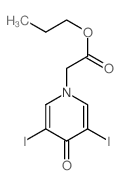CHEMICAL IDENTIFICATION
-
RTECS NUMBER :
-
UR8925000
-
CHEMICAL NAME :
-
1(4H)-Pyridineacetic acid, 3,5-diiodo-4-oxo-, propyl ester
-
CAS REGISTRY NUMBER :
-
587-61-1
-
BEILSTEIN REFERENCE NO. :
-
0206829
-
LAST UPDATED :
-
199612
-
DATA ITEMS CITED :
-
3
-
MOLECULAR FORMULA :
-
C10-H11-I2-N-O3
-
MOLECULAR WEIGHT :
-
447.02
-
WISWESSER LINE NOTATION :
-
T6N DVJ A1VO3 CI EI
HEALTH HAZARD DATA
ACUTE TOXICITY DATA
-
TYPE OF TEST :
-
LD50 - Lethal dose, 50 percent kill
-
ROUTE OF EXPOSURE :
-
Oral
-
SPECIES OBSERVED :
-
Rodent - mouse
-
DOSE/DURATION :
-
>18 gm/kg
-
TOXIC EFFECTS :
-
Kidney, Ureter, Bladder - other changes
-
REFERENCE :
-
BJPCAL British Journal of Pharmacology and Chemotherapy. (London, UK) V.1-33, 1946-68. For publisher information, see BJPCBM. Volume(issue)/page/year: 8,166,1953
-
TYPE OF TEST :
-
LD50 - Lethal dose, 50 percent kill
-
ROUTE OF EXPOSURE :
-
Intravenous
-
SPECIES OBSERVED :
-
Rodent - mouse
-
DOSE/DURATION :
-
300 mg/kg
-
TOXIC EFFECTS :
-
Vascular - acute arterial occlusion
-
REFERENCE :
-
BJPCAL British Journal of Pharmacology and Chemotherapy. (London, UK) V.1-33, 1946-68. For publisher information, see BJPCBM. Volume(issue)/page/year: 8,166,1953
-
TYPE OF TEST :
-
LD50 - Lethal dose, 50 percent kill
-
ROUTE OF EXPOSURE :
-
Unreported
-
SPECIES OBSERVED :
-
Rodent - mouse
-
DOSE/DURATION :
-
300 mg/kg
-
TOXIC EFFECTS :
-
Details of toxic effects not reported other than lethal dose value
-
REFERENCE :
-
YAKUD5 Gekkan Yakuji. Pharmaceuticals Monthly. (Yakugyo Jihosha, Inaoka Bldg., 2-36 Jinbo-cho, Kanda, Chiyoda-ku, Tokyo 101, Japan) V.1- 1959- Volume(issue)/page/year: 26,921,1984
|
